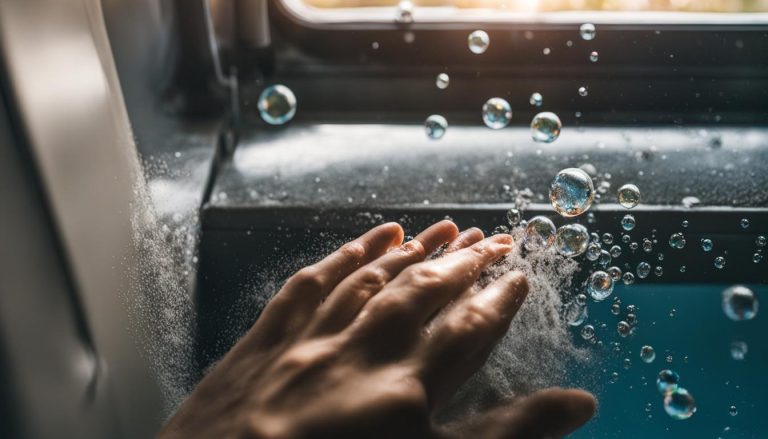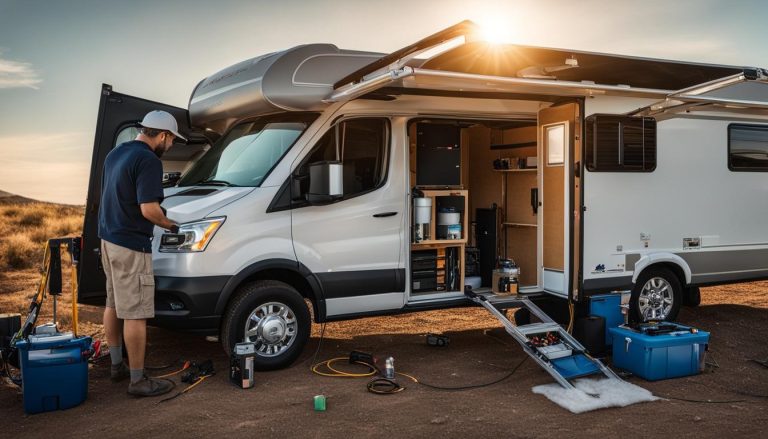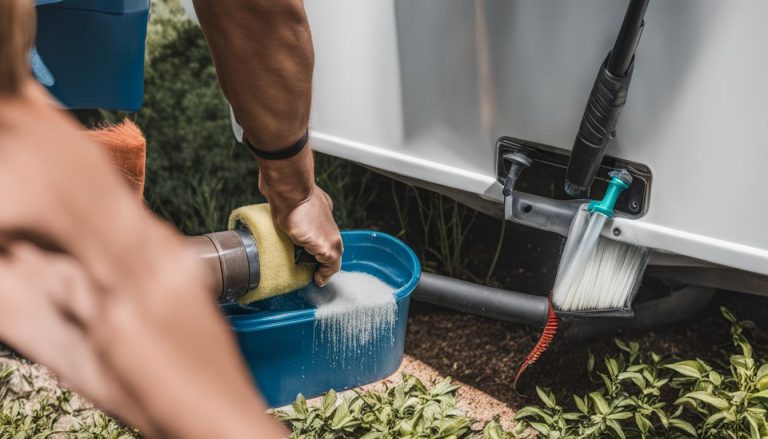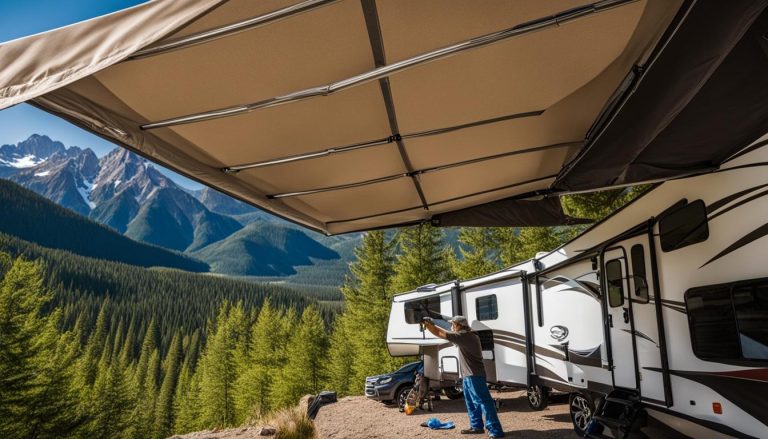Hook Up Your RV to Home Power Safely
gorvlifestyle.com and its partners may earn a commission if you purchase a product through one of our links
To fully enjoy the comforts of your RV while parked at home, it’s essential to know how to connect your RV to your house’s electrical system. Whether you’re preparing for a road trip or need additional power for your RV, proper connections are crucial to ensure safety and avoid any electrical complications.
Before hooking up your RV to your home power, it’s important to understand the different connection methods available and the limitations that come with them. This knowledge will help you make informed decisions and enjoy a seamless power supply during your RV adventures.
Key Takeaways:
- Understanding how to connect your RV to your home’s electrical system ensures a safe and reliable power supply.
- Installing a 30/50 Amp hookup at home provides compatibility with your RV’s electrical needs.
- Using an outdoor, all-weather extension cord and adapter allows you to connect your RV to a standard household outlet.
- Power limitations exist when connecting an RV to a home’s electrical system, particularly with high-energy appliances.
- Knowing the differences between 30 and 50 Amp RV electrical hookup systems helps you select the appropriate campsite for your RV’s electrical needs.
How to Connect Your RV to a Home’s Electrical System
If you are hooking up to a home’s standard outlet, you can do this using an outdoor, all-weather extension cord and a 15/20 Amp adapter for your RV’s electrical hookups. Make sure the extension cord is as short as possible to prevent overheating.
Before plugging in the extension cord, ensure that all electrical appliances in your RV and the breakers in your home are turned off. Then, plug the extension cord into your RV’s electrical hookups and reset the breakers in your home. If successful, your RV will be properly connected to the home’s electrical system.
If the breaker trips, unplug everything and check that all appliances in your RV are turned off before trying again. If you still encounter issues, refer to your RV’s manual, contact the manufacturer, or consult a dealership for assistance.
| Steps to Connect Your RV to a Home’s Electrical System | Note: |
|---|---|
| 1. Turn off all electrical appliances in your RV and the breakers in your home. | Important: Ensure safety and avoid electrical mishaps. |
| 2. Plug the outdoor, all-weather extension cord into your RV’s electrical hookups. | Pro tip: Use a short extension cord to prevent overheating. |
| 3. Reset the breakers in your home. | Caution: Be cautious during the process to prevent electrical hazards. |
| 4. Check the connection and ensure your RV is properly connected to the home’s electrical system. | Verification: Ensure a successful connection for power supply. |
Power Limitations When Hooking Up an RV to a Home’s Electrical System
When connecting your RV to a home’s electrical system, it’s important to be aware of the power limitations that may arise. A standard household outlet typically provides a 15/20 Amp connection, while your RV will require at least a 30/50 Amp hookup to power all of its appliances. This means that in most cases, you’ll only be able to use one appliance at a time to avoid tripping the breaker.
Some appliances, such as air conditioning units, heaters, hairdryers, microwaves, toasters, and toaster ovens, are considered electric hogs. These appliances draw a significant amount of power and should be used with caution, especially when running multiple appliances simultaneously. However, appliances like TVs, DVD players, laptops, and refrigerators usually consume less power and can typically be used simultaneously without overloading the electrical connection.
If you’re hooking up your RV to a home’s electrical system, it’s recommended to conserve energy by using the appliances in your home instead of running them in the RV whenever possible. Not only will this help avoid overloading the electrical connection, but it can also help save energy and reduce your electricity bill.
Here’s a table summarizing the power limitations for common RV appliances:
| Appliance | Power Consumption (in Watts) |
|---|---|
| Air Conditioning Unit | 1,200 – 3,500 |
| Heater | 1,500 – 2,500 |
| Hairdryer | 1,200 – 1,875 |
| Microwave | 600 – 1,500 |
| Toaster | 800 – 1,500 |
| Toaster Oven | 1,200 – 1,800 |
| TV | 30 – 300 |
| DVD Player | 25 – 50 |
| Laptop | 50 – 100 |
| Refrigerator | 120 – 500 |
Keep in mind that these power consumptions are approximate and may vary depending on the specific make and model of the appliance. Always refer to the manufacturer’s specifications for the accurate power requirements of your RV appliances.
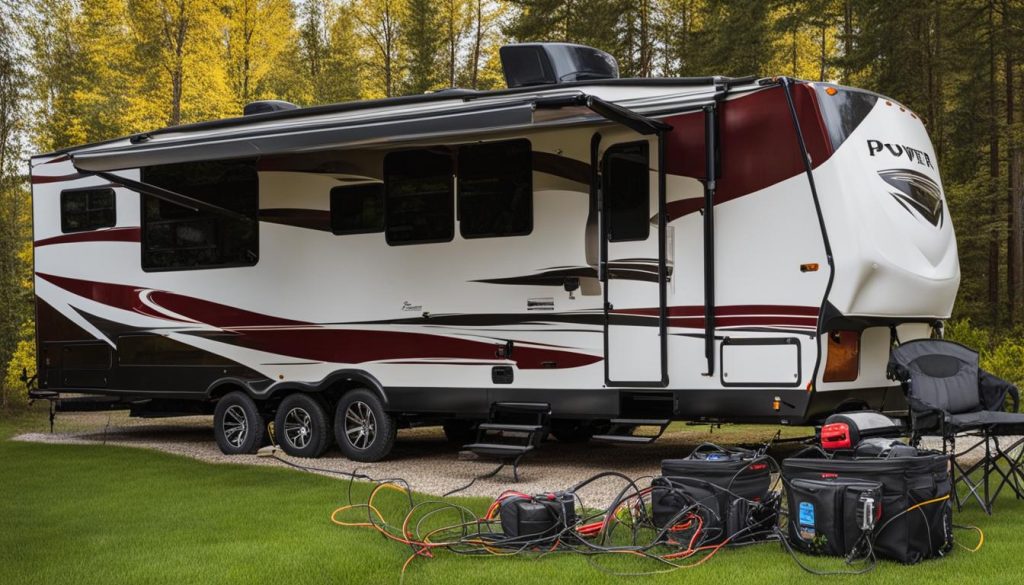
As you hook up your RV to a home’s electrical system, understanding the power limitations and responsibly managing appliance usage will help ensure a safe and efficient experience.
Differences Between 30 and 50 Amp RV Electrical Hookup Systems
When it comes to RV electrical hookups, understanding the differences between 30 and 50 Amp systems is crucial. These hookups provide different levels of power, which can impact the number of appliances you can run in your RV without tripping the breaker.
A 30 Amp RV hookup offers a power capacity of 3,600 watts, while a 50 Amp hookup provides over 12,000 watts. With a 30 Amp system, you’ll have less power available, meaning you’ll need to be more mindful of the appliances you run simultaneously to avoid overpowering the system.
To ensure a smooth and hassle-free camping experience, it’s essential to ensure that the electrical hookup available at the campground matches the electrical system of your RV. This will help avoid any compatibility issues and ensure that you have access to the power you need throughout your trip.
| RV Electrical Hookup Systems | Power Capacity (Watts) |
|---|---|
| 30 Amp | 3,600 |
| 50 Amp | 12,000+ |
Some RVs come equipped with both a 30 Amp and a 15 Amp adapter, providing flexibility when it comes to electrical connections. However, if your RV has a specific electrical system, it’s best to select campsites that offer the appropriate hookup for your RV. This will simplify the connection process and ensure optimal performance.
Understanding the electrical capacity of your RV and the available hookup options at campsites will help you make informed decisions and avoid any potential issues. It’s always better to be prepared and knowledgeable about your RV’s electrical system setup and the different power connection methods available.
Step-by-Step Guide to Connecting Your RV’s Electrical System at a Campground
When it comes to connecting your RV’s electrical system at a campground, following a step-by-step guide is crucial for a smooth and safe connection. Here’s a simple guide to help you navigate the process:
- Step 1: Arrival and Preparation
Once you arrive at the campground and locate the electrical hookup, take a moment to ensure that everything is turned off in your RV. Additionally, be sure to shut off the campsite’s power supply before proceeding.
- Step 2: Plug into the Power Box
Using an adapter if necessary, plug your RV’s plug into the campground power box. This will establish the electrical connection between your RV and the power source at the campground.
- Step 3: Switch on the Breaker
After plugging in your RV, locate the campsite’s breaker and switch it back on. This will restore power to your RV.
Pro Tip: It’s always a good idea to double-check that all appliances in your RV are turned off before switching on the breaker to avoid any power surges.
- Step 4: Confirm Power Connection
At this point, your RV should be successfully connected to the campground’s electrical system. You can now check inside your RV to ensure that all the lights and electrical appliances are functioning properly.
- Step 5: Disconnecting Your RV
When it’s time to leave the campground, simply follow the same steps in reverse to disconnect your RV. Unplug your RV from the power box and make sure to shut off the campground’s breaker before you leave.
Pro Tip: Before disconnecting, make sure to turn off all appliances and lights inside your RV to avoid any power surges when unplugging.
Following this step-by-step guide will help you connect your RV’s electrical system at a campground safely and efficiently. Now, you can enjoy all the comforts and conveniences of your RV while on your outdoor adventure!
Next, let’s explore how to connect your RV’s electrical system to your home for added convenience and functionality.
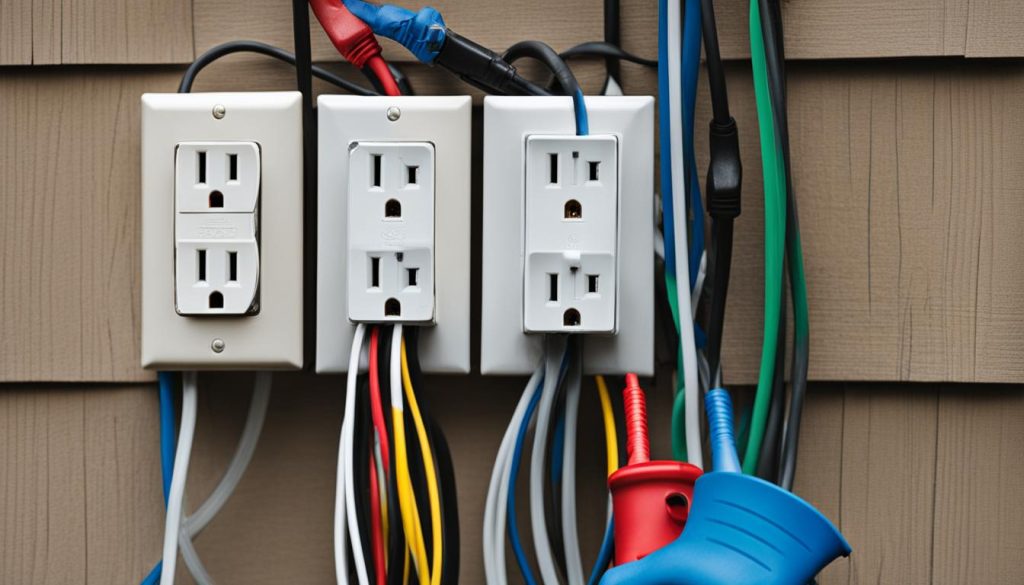
Step-by-Step Guide to Connecting Your RV’s Electrical System at a Campground
| Steps | Description |
|---|---|
| Step 1 | Arrival and Preparation |
| Step 2 | Plug into the Power Box |
| Step 3 | Switch on the Breaker |
| Step 4 | Confirm Power Connection |
| Step 5 | Disconnecting Your RV |
Connecting Your RV’s Electrical System to Your Home
There may be instances when you need to connect your RV’s electrical system to your home. Whether it’s for a quick check before a road trip or to power appliances like refrigerators, you can perform an RV electrical hookup at home with the proper equipment.
You will need a three-prong connector and a 30/50 Amp adapter to connect to a standard household outlet. Before connecting, ensure that the breakers in your home and your RV are turned off. Then, plug the RV into the house using the connector and adapter. Finally, switch the breakers back on, and your RV should have power. Keep in mind that running your RV’s appliances off your home’s electrical grid for an extended period may increase your electricity bill.
| Equipment | Instructions |
|---|---|
| Three-prong connector | Plug one end into the RV’s electrical hookups and the other end into the house’s outlet. |
| 30/50 Amp adapter | Connect the adapter to the three-prong connector and ensure a secure fit. |
| Breakers | Ensure that both the home’s breakers and the RV’s breakers are in the “Off” position before making the connection. |
| Power | Switch the breakers back on after the RV is plugged in to provide power. |
By following these steps and using the appropriate equipment, you can safely connect your RV’s electrical system to your home, allowing you to use your RV’s appliances and power sources conveniently. Just remember to be mindful of your electricity usage to avoid any unexpected increases in your billing.
Safety Considerations When Connecting an RV to Household Power
When connecting your RV to household power, it is essential to prioritize safety to prevent damage to your RV and home’s electrical system. Take the time to familiarize yourself with how both systems work before attempting the hookup. If you are uncertain about connecting your RV in your driveway or any other location, reach out to reliable sources such as online forums, dealerships, or experienced RVers for guidance. Improperly connecting your RV can lead to costly repairs and potential safety hazards.
To ensure a safe and successful RV electricity hookup, follow these important precautions:
- Read the manuals: Familiarize yourself with the electrical setup of your RV and the specific requirements for connecting it to household power. Understand the necessary equipment, wiring diagrams, and safety guidelines relevant to your RV model.
- Inspect the electrical systems: Before connecting your RV, inspect both the RV’s electrical system and the household power source. Look for any visible damage, frayed wires, loose connections, or signs of wear. If you notice any issues or have concerns, consult a qualified electrician or RV technician for evaluation and repairs.
- Use appropriate equipment: Ensure that you have the correct adapters, cords, and connectors designed for RV electrical hookups. Improper equipment can lead to overloading, electrical surges, and potential fires. Always use equipment that meets the necessary electrical standards and is compatible with your RV’s electrical system.
- Turn off all appliances and breakers: Before making the connection, turn off all appliances and breakers in your RV and home. This precaution prevents sudden power surges and helps maintain the stability of the electrical system during the hookup process.
- Secure and protect the cord: When connecting the RV to the household power supply, make sure the electrical cord is properly secured. Avoid running the cord across walkways or areas prone to tripping hazards. Additionally, protect the cord from damage caused by direct sunlight, sharp objects, or extreme weather conditions.
- Double-check the connection: Once connected, double-check that the RV is securely plugged into the power source. Ensure that the connection is tight and that there are no exposed wires or loose connections. If you notice any issues, disconnect the RV immediately and do not attempt to force the connection.
- Regularly monitor the connection: While your RV is connected to household power, periodically check the connection for any signs of overheating, strange odors, or sparking. If you detect any abnormalities, disconnect the RV and consult a professional for inspection and necessary repairs.
By following these safety considerations and taking the necessary precautions, you can enjoy a worry-free RV electricity hookup experience while keeping your RV and home protected.
Conclusion
Connecting your RV to your home’s electrical system can provide you with the convenience of electricity while in your driveway or during a short stay at someone else’s property. However, it is important to understand the limitations and safety considerations involved in the RV electricity hookup process.
Always ensure that you have the proper electrical hookups and equipment in place before attempting to connect your RV to your home’s power. Following a step-by-step guide for proper connection is crucial to avoid any issues or damage to your electrical system. If you are uncertain about the process, it is advisable to consult experts or experienced RVers for guidance.
By adhering to safety practices and staying well-informed, you can enjoy the benefits of a connected RV power source while ensuring the safety of both your RV and your home’s electrical system. Take the necessary precautions, follow the guidelines, and make the most of your RV power connection methods to enhance your RVing experience.
FAQ
How do I connect my RV to my home’s electrical system?
To connect your RV to your home’s electrical system, it is recommended to either have the necessary hookups installed when purchasing the RV or to install a 30/50 Amp hookup at your home. If you are hooking up to a standard household outlet, you can use an outdoor, all-weather extension cord and a 15/20 Amp adapter.
What should I consider when connecting my RV to a home’s electrical system?
It is important to note that a standard household outlet provides a lower amp capacity compared to a 30/50 Amp hookup. This means you may be limited in terms of the appliances you can run and may only be able to use one appliance at a time. Electric hogs, such as air conditioning units and hairdryers, should be used with caution to avoid overloading the electrical connection.
What are the differences between 30 and 50 Amp RV electrical hookup systems?
A 30 Amp hookup provides 3,600 watts of power, while a 50 Amp hookup provides over 12,000 watts. The choice between the two depends on the electrical system of your RV and the number of appliances you want to run simultaneously without tripping the breaker.
Can you provide a step-by-step guide for connecting an RV’s electrical system at a campground?
Once you arrive at the campground, turn off everything in your RV and shut off the campsite’s power supply. Then, plug your RV’s plug into the campground power box using an adapter if necessary and switch the campsite’s breaker back on.
How can I connect my RV’s electrical system to my home?
To connect your RV’s electrical system to your home, you will need a three-prong connector and a 30/50 Amp adapter. Before connecting, ensure that the breakers in your home and your RV are turned off. Then, plug the RV into the house using the connector and adapter and switch the breakers back on.
What are some safety considerations when connecting an RV to household power?
It is crucial to understand how your RV and home’s electrical systems work before making the connection. Consult experts if needed and ensure you have the proper electrical hookups and equipment to avoid any issues or damage.

